wheel size Lancia Delta 2010 Owner handbook (in English)
[x] Cancel search | Manufacturer: LANCIA, Model Year: 2010, Model line: Delta, Model: Lancia Delta 2010Pages: 276, PDF Size: 5.31 MB
Page 112 of 276

GETTING TO KNOW YOUR CAR111
1
Failure indications
System failure is indicated by warning light
álighting up
on the instrument panel together with a dedicated mes-
sage appearing on the reconfigurable multifunctional dis-
play; see “Instrument panel warning lights”.
IMPORTANT The Hill Holder system is not a parking
brake; therefore, never leave the car without having en-
gaged the handbrake, turned the engine off and engaged
first gear.
If the small spare wheel is used, the Advanced
ESP system is still operational. Be aware,
however, that as the small spare wheel is
smaller than the original wheel, it provides less grip.
In order for the Advanced ESP and ASR systems to
operate correctly, the tyres must be of the same brand
and type on all wheels, in perfect condition and,
above all, be of the specified type, brand and size.
HILL HOLDER SYSTEM
This is an integral part of the ESP system and automati-
cally cuts in if one or both drive wheels slip, helping the
driver to control the car:
❍uphill: car at a standstill on a road with a gradient
higher than 5%, engine running, clutch and brake ped-
al pressed, gearbox to neutral or gear engaged other
than reverse;
❍downhill: car at a standstill on a road with a gradient
higher than 5%, engine running, clutch and brake ped-
al pressed and reverse gear engaged.
At take-off the Advanced ESP system control unit will
maintain a brake force on the wheels until the torque re-
quired for setting off is reached, or in any case for a max-
imum of 2 seconds so that the right foot can be moved eas-
ily from the brake pedal to the accelerator pedal.
After two seconds without setting off, the system will de-
activate automatically, gradually releasing the brake force.
During the release stage, the typical brake disengagement
noise may be heard, indicating that the car is going to
move.
001-142 Delta 3ed gb 30-11-2009 11:22 Pagina 111
Page 120 of 276

GETTING TO KNOW YOUR CAR119
1
Contact a
Lancia Dealership
Repairing a damaged
wheel
Contact a
Lancia Dealership
–
Contact a
Lancia Dealership.
––
NO
NO
YES
YES
YESYES
YES
YES
NO
NO
NO
(*) Given as an alternative in the Owner’s Handbook and available at Lineaccessori Lancia.
(**) Not swapped (tyres must stay on the same side).
In order to use the system properly, refer to the following table when you have to change wheels/tyres:
Operation Presence of sensor Indication Service Operation
fault Authorised Personnel
Lancia
–
Replacing a wheel with the
spare wheel
Replacing the wheels
with winter tyres
Replacing the wheels
with winter tyres
Replacing the wheels
with others of a different size (*)
Swapping the wheels
(front/rear) (**)
001-142 Delta 3ed gb 30-11-2009 11:22 Pagina 119
Page 126 of 276

GETTING TO KNOW YOUR CAR125
1
❍Identification: if the system identifies a free parking
space that is a suitable size for the vehicle, it signals its
presence and indicates the actions required for starting the
manoeuvre.
❍Manoeuvre: the driver is asked to engage reverse gear
and leave the steering wheel and manage the accelerator,
brake and clutch (in the case of manual transmission) or
accelerator and brake (in the case of automatic transmis-
sion). The system manages the steering wheel automat-
ically when reverse gear is engaged in the parking posi-
tion.
It suggests that the manoeuvre be concluded in reverse
gear (if the conditions permit) when the continuous sound
of the buzzer for the rear sensors is heard.
IMPORTANT The MANOEUVRE stage in the system log-
ic is deactivated after about 3 mins if the parking ma-
noeuvre has not been completed.❍Conclusion: If parking space is big enough, the ma-
noeuvre is completed by the system in one stage and the
positioning of the vehicle does not require any further in-
tervention on behalf of the driver. If further corrective
manoeuvres are required, the system returns control to the
driver who must complete the manoeuvre manually.
IMPORTANT Steering will be realigned after reversing
when reverse gear is disengaged. The driver must com-
plete the manoeuvre by hand.
The operation of the parking assistance is
based on different components:
❍front and rear parking sensors;
❍side sensors;
❍electric steering;
❍wheels and braking system;
❍instrument panel.
It is necessary to bear in mind that a malfunction
in one of these systems could compromise the op-
eration of the Magic Parking system.
001-142 Delta 3ed gb 30-11-2009 11:22 Pagina 125
Page 130 of 276

GETTING TO KNOW YOUR CAR129
1
If the driver carries out a voluntary or involuntary action
on the steering during the parking manoeuvre (touching it
or preventing its movement), the manoeuvre will be in-
terrupted.
If the road surface is very uneven or there are obstacles un-
der the wheels affecting the movement of the vehicle, pre-
venting it from continuing along the correct trajectory, the
manoeuvre may be interrupted.
Conclusion of manoeuvre
If the size of parking space permits, the parking manoeu-
vre may be performed in one go, when reverse gear is re-
leased the wheels will be realigned and the manoeuvre will
be considered completed and the system will consequent-
ly be deactivated. If the size of the parking space is small-
er, it may take several manoeuvres, the driver will be ad-
vised to complete the parking manoeuvre manually via a
dedicated messages in the instrument panel display. General warnings
❍The ultimate responsibility when parking and carrying
out other dangerous manoeuvres always rests with the dri-
ver. Always make sure that there are no people, animals or
objects in the way when carrying out these manoeuvres.
The Magic Parking system (like parking sensors) is de-
signed to assist drivers: in all cases, you must always pay
the utmost attention during potentially dangerous ma-
noeuvres, even when these are carried out a low speed:
❍If the sensors are affected by impacts that alter their
position, the operation of the system may be greatly re-
duced.
❍If the sensors are dirty, covered in snow, ice, mud or
paint, the operation of the system could be greatly reduced.
❍It is vital that the sensors are always clean in order for
the system to work properly. Take great care when clean-
ing the sensors not to scratch or damage them; avoid us-
ing dry, rough or hard cloths. The sensors should be washed
with clean water with possibly some car shampoo added.
In washing stations, clean the sensors quickly, keeping the
steam jet/high pressure washing nozzles at least 10 cm
away from the sensors.
If you wish to stop the steering wheel with
your hands during a manoeuvre, it is advis-
able to handle it firmly on the outer rim. Do
not try and keep your hands on the inside or hold
the actual spokes.
001-142 Delta 3ed gb 30-11-2009 11:22 Pagina 129
Page 131 of 276
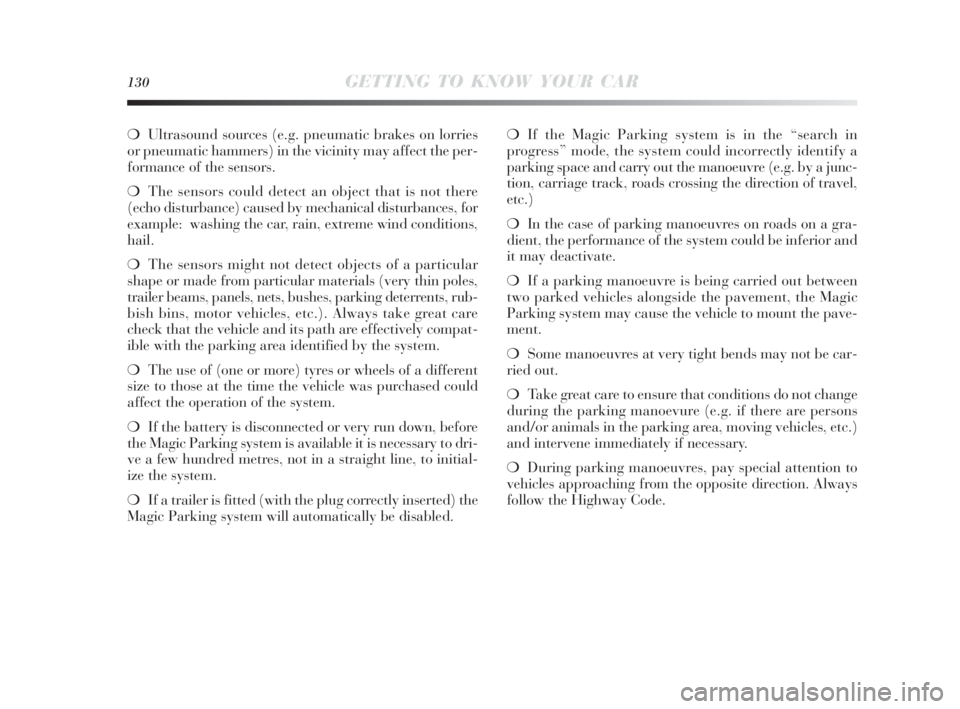
130GETTING TO KNOW YOUR CAR
❍Ultrasound sources (e.g. pneumatic brakes on lorries
or pneumatic hammers) in the vicinity may affect the per-
formance of the sensors.
❍The sensors could detect an object that is not there
(echo disturbance) caused by mechanical disturbances, for
example: washing the car, rain, extreme wind conditions,
hail.
❍The sensors might not detect objects of a particular
shape or made from particular materials (very thin poles,
trailer beams, panels, nets, bushes, parking deterrents, rub-
bish bins, motor vehicles, etc.). Always take great care
check that the vehicle and its path are effectively compat-
ible with the parking area identified by the system.
❍The use of (one or more) tyres or wheels of a different
size to those at the time the vehicle was purchased could
affect the operation of the system.
❍If the battery is disconnected or very run down, before
the Magic Parking system is available it is necessary to dri-
ve a few hundred metres, not in a straight line, to initial-
ize the system.
❍If a trailer is fitted (with the plug correctly inserted) the
Magic Parking system will automatically be disabled.❍If the Magic Parking system is in the “search in
progress” mode, the system could incorrectly identify a
parking space and carry out the manoeuvre (e.g. by a junc-
tion, carriage track, roads crossing the direction of travel,
etc.)
❍In the case of parking manoeuvres on roads on a gra-
dient, the performance of the system could be inferior and
it may deactivate.
❍If a parking manoeuvre is being carried out between
two parked vehicles alongside the pavement, the Magic
Parking system may cause the vehicle to mount the pave-
ment.
❍Some manoeuvres at very tight bends may not be car-
ried out.
❍Take great care to ensure that conditions do not change
during the parking manoevure (e.g. if there are persons
and/or animals in the parking area, moving vehicles, etc.)
and intervene immediately if necessary.
❍During parking manoeuvres, pay special attention to
vehicles approaching from the opposite direction. Always
follow the Highway Code.
001-142 Delta 3ed gb 30-11-2009 11:22 Pagina 130
Page 174 of 276
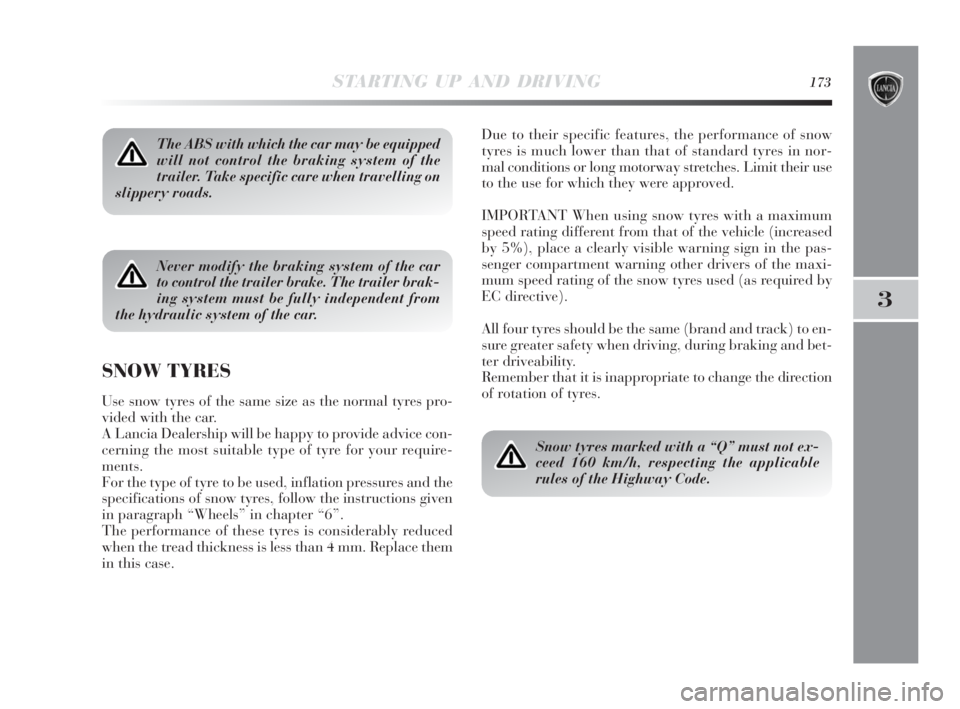
STARTING UP AND DRIVING173
3
The ABS with which the car may be equipped
will not control the braking system of the
trailer. Take specific care when travelling on
slippery roads.
Never modify the braking system of the car
to control the trailer brake. The trailer brak-
ing system must be fully independent from
the hydraulic system of the car.
SNOW TYRES
Use snow tyres of the same size as the normal tyres pro-
vided with the car.
A Lancia Dealership will be happy to provide advice con-
cerning the most suitable type of tyre for your require-
ments.
For the type of tyre to be used, inflation pressures and the
specifications of snow tyres, follow the instructions given
in paragraph “Wheels” in chapter “6”.
The performance of these tyres is considerably reduced
when the tread thickness is less than 4 mm. Replace them
in this case.Due to their specific features, the performance of snow
tyres is much lower than that of standard tyres in nor-
mal conditions or long motorway stretches. Limit their use
to the use for which they were approved.
IMPORTANT When using snow tyres with a maximum
speed rating different from that of the vehicle (increased
by 5%), place a clearly visible warning sign in the pas-
senger compartment warning other drivers of the maxi-
mum speed rating of the snow tyres used (as required by
EC directive).
All four tyres should be the same (brand and track) to en-
sure greater safety when driving, during braking and bet-
ter driveability.
Remember that it is inappropriate to change the direction
of rotation of tyres.
Snow tyres marked with a “Q” must not ex-
ceed 160 km/h, respecting the applicable
rules of the Highway Code.
165-174 Delta 3ed gb 11-11-2009 12:10 Pagina 173
Page 175 of 276
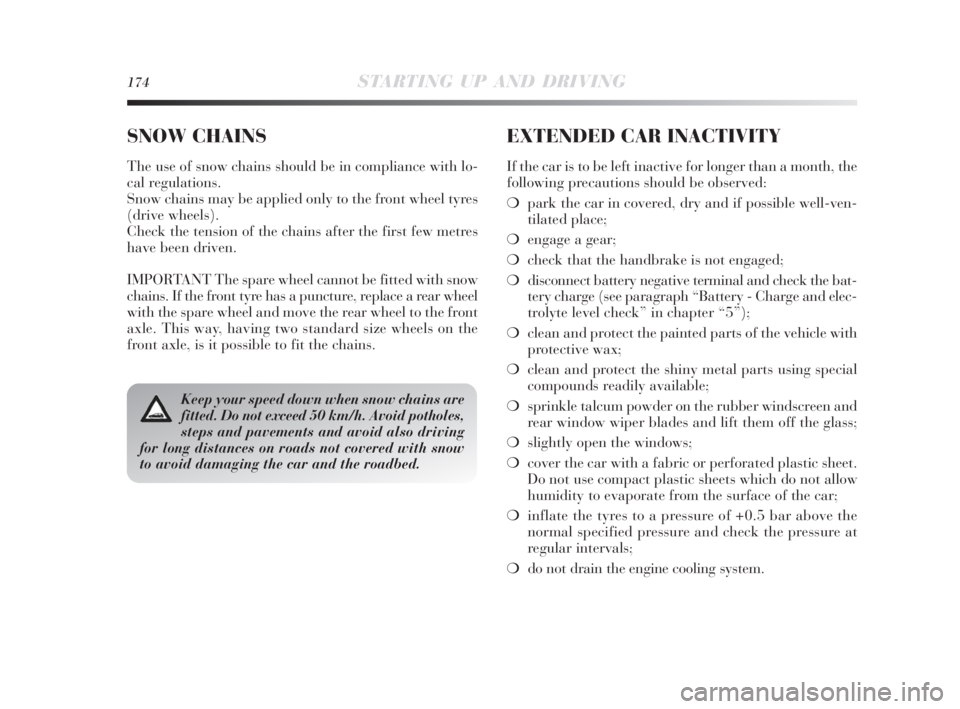
174STARTING UP AND DRIVING
Keep your speed down when snow chains are
fitted. Do not exceed 50 km/h. Avoid potholes,
steps and pavements and avoid also driving
for long distances on roads not covered with snow
to avoid damaging the car and the roadbed.
SNOW CHAINS
The use of snow chains should be in compliance with lo-
cal regulations.
Snow chains may be applied only to the front wheel tyres
(drive wheels).
Check the tension of the chains after the first few metres
have been driven.
IMPORTANT The spare wheel cannot be fitted with snow
chains. If the front tyre has a puncture, replace a rear wheel
with the spare wheel and move the rear wheel to the front
axle. This way, having two standard size wheels on the
front axle, is it possible to fit the chains.
EXTENDED CAR INACTIVITY
If the car is to be left inactive for longer than a month, the
following precautions should be observed:
❍park the car in covered, dry and if possible well-ven-
tilated place;
❍engage a gear;
❍check that the handbrake is not engaged;
❍disconnect battery negative terminal and check the bat-
tery charge (see paragraph “Battery - Charge and elec-
trolyte level check” in chapter “5”);
❍clean and protect the painted parts of the vehicle with
protective wax;
❍clean and protect the shiny metal parts using special
compounds readily available;
❍sprinkle talcum powder on the rubber windscreen and
rear window wiper blades and lift them off the glass;
❍slightly open the windows;
❍cover the car with a fabric or perforated plastic sheet.
Do not use compact plastic sheets which do not allow
humidity to evaporate from the surface of the car;
❍inflate the tyres to a pressure of +0.5 bar above the
normal specified pressure and check the pressure at
regular intervals;
❍do not drain the engine cooling system.
165-174 Delta 3ed gb 11-11-2009 12:10 Pagina 174
Page 186 of 276
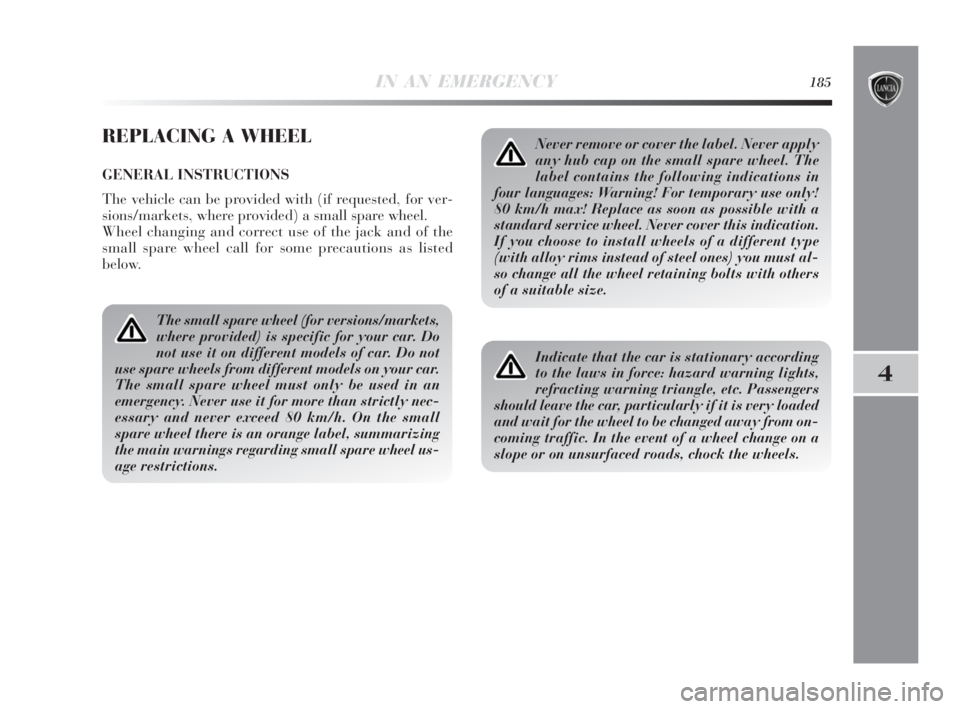
IN AN EMERGENCY185
4
REPLACING A WHEEL
GENERAL INSTRUCTIONS
The vehicle can be provided with (if requested, for ver-
sions/markets, where provided) a small spare wheel.
Wheel changing and correct use of the jack and of the
small spare wheel call for some precautions as listed
below.
The small spare wheel (for versions/markets,
where provided) is specific for your car. Do
not use it on different models of car. Do not
use spare wheels from different models on your car.
The small spare wheel must only be used in an
emergency. Never use it for more than strictly nec-
essary and never exceed 80 km/h. On the small
spare wheel there is an orange label, summarizing
the main warnings regarding small spare wheel us-
age restrictions.
Never remove or cover the label. Never apply
any hub cap on the small spare wheel. The
label contains the following indications in
four languages: Warning! For temporary use only!
80 km/h max! Replace as soon as possible with a
standard service wheel. Never cover this indication.
If you choose to install wheels of a different type
(with alloy rims instead of steel ones) you must al-
so change all the wheel retaining bolts with others
of a suitable size.
Indicate that the car is stationary according
to the laws in force: hazard warning lights,
refracting warning triangle, etc. Passengers
should leave the car, particularly if it is very loaded
and wait for the wheel to be changed away from on-
coming traffic. In the event of a wheel change on a
slope or on unsurfaced roads, chock the wheels.
175-214 Delta 4ed gb 24-02-2010 14:36 Pagina 185
Page 193 of 276
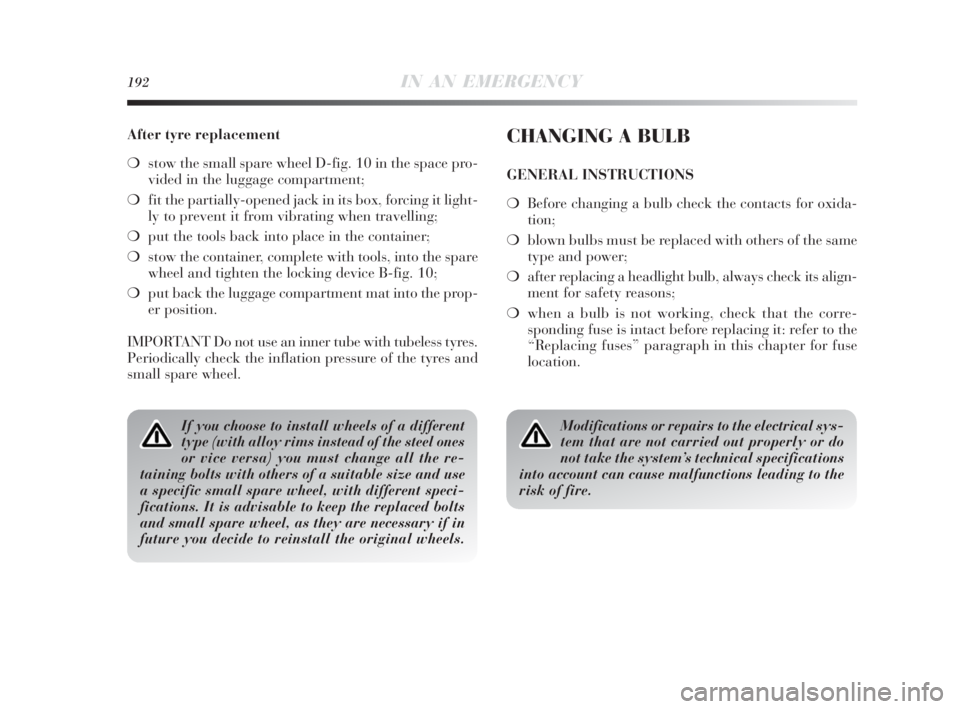
192IN AN EMERGENCY
After tyre replacement
❍stow the small spare wheel D-fig. 10 in the space pro-
vided in the luggage compartment;
❍fit the partially-opened jack in its box, forcing it light-
ly to prevent it from vibrating when travelling;
❍put the tools back into place in the container;
❍stow the container, complete with tools, into the spare
wheel and tighten the locking device B-fig. 10;
❍put back the luggage compartment mat into the prop-
er position.
IMPORTANT Do not use an inner tube with tubeless tyres.
Periodically check the inflation pressure of the tyres and
small spare wheel.CHANGING A BULB
GENERAL INSTRUCTIONS
❍Before changing a bulb check the contacts for oxida-
tion;
❍blown bulbs must be replaced with others of the same
type and power;
❍after replacing a headlight bulb, always check its align-
ment for safety reasons;
❍when a bulb is not working, check that the corre-
sponding fuse is intact before replacing it: refer to the
“Replacing fuses” paragraph in this chapter for fuse
location.
Modifications or repairs to the electrical sys-
tem that are not carried out properly or do
not take the system’s technical specifications
into account can cause malfunctions leading to the
risk of fire. If you choose to install wheels of a different
type (with alloy rims instead of the steel ones
or vice versa) you must change all the re-
taining bolts with others of a suitable size and use
a specific small spare wheel, with different speci-
fications. It is advisable to keep the replaced bolts
and small spare wheel, as they are necessary if in
future you decide to reinstall the original wheels.
175-214 Delta 4ed gb 24-02-2010 14:36 Pagina 192
Page 253 of 276
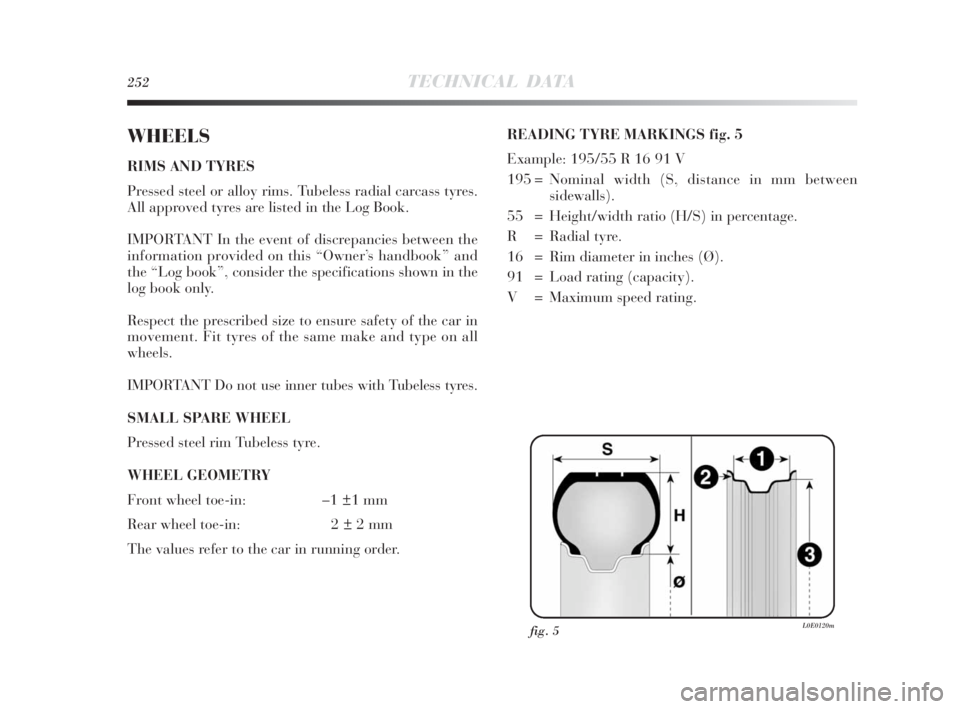
252TECHNICAL DATA
WHEELS
RIMS AND TYRES
Pressed steel or alloy rims. Tubeless radial carcass tyres.
All approved tyres are listed in the Log Book.
IMPORTANT In the event of discrepancies between the
information provided on this “Owner’s handbook” and
the “Log book”, consider the specifications shown in the
log book only.
Respect the prescribed size to ensure safety of the car in
movement. Fit tyres of the same make and type on all
wheels.
IMPORTANT Do not use inner tubes with Tubeless tyres.
SMALL SPARE WHEEL
Pressed steel rim Tubeless tyre.
WHEEL GEOMETRY
Front wheel toe-in: –1
±1 mm
Rear wheel toe-in: 2
± 2 mm
The values refer to the car in running order.READING TYRE MARKINGS fig. 5
Example: 195/55 R 16 91 V
195 = Nominal width (S, distance in mm between
sidewalls).
55 = Height/width ratio (H/S) in percentage.
R = Radial tyre.
16 = Rim diameter in inches (Ø).
91 = Load rating (capacity).
V = Maximum speed rating.
fig. 5L0E0120m
243-266 Delta 3ed gb 11-11-2009 12:16 Pagina 252